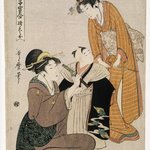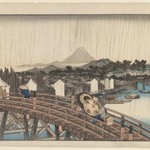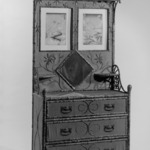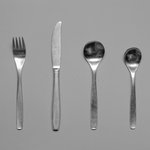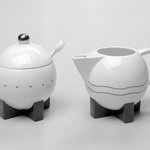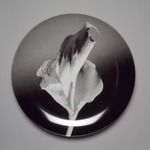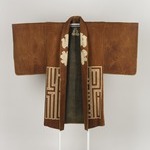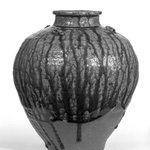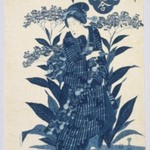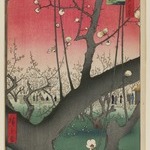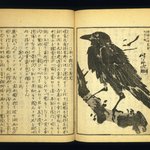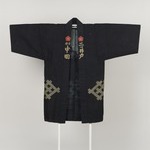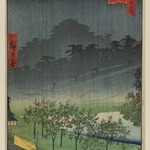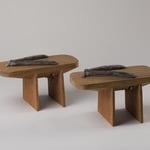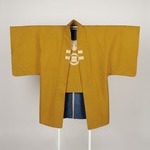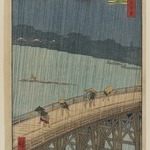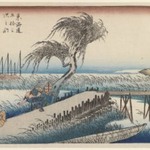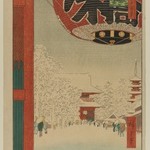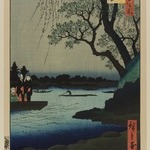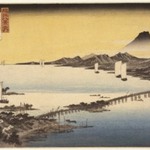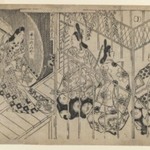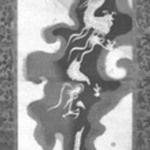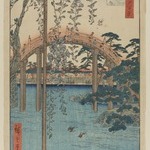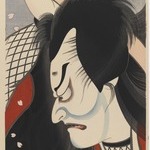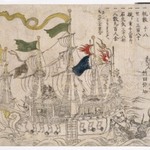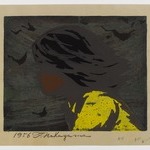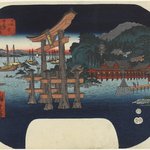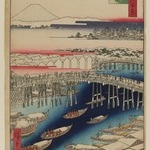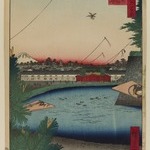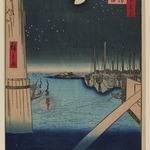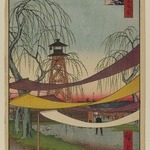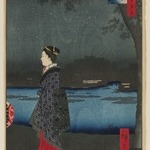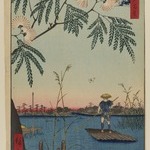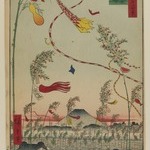
Kanasugi Bridge and Shibaura, No. 80 from One Hundred Famous Views of Edo
Utagawa Hiroshige
Asian Art
This colorful procession is a group of Nichiren Buddhists crossing the Kanasugi Bridge along the stretch of coast known as Shibaura. The autumn season assigned to the print suggests that it is Oeshiki, the thirteenth day of the Tenth Month, the day Nichiren, the founder of this particular Buddhist sect, died in 1282. Whether the procession is en route to or returning from its destination, the temple where Nichiren died, is unclear. Perhaps what Hiroshige has done is to show the two faces of the pilgrimage: the exuberant setting out under fluttering banners in the foreground, and the exhausted return of the pilgrims in the background, huddled under hats and umbrellas.
MEDIUM
Woodblock print
DATES
7th month of 1857
PERIOD
Edo Period, Ansei Era
DIMENSIONS
Sheet: 14 3/16 x 9 1/4 in. (36 x 23.5 cm)
Image: 13 3/8 x 8 3/4 in. (34 x 22.2 cm) (show scale)
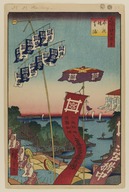


MARKINGS
No publisher's seal visible; probably lost when left margin was trimmed. date seal and censor seal at top margin.
SIGNATURE
Hiroshige-ga
COLLECTIONS
Asian Art
ACCESSION NUMBER
30.1478.80
CREDIT LINE
Gift of Anna Ferris
PROVENANCE
Prior to 1930, provenance not yet documented; by 1930, acquired by Anna Ferris of Summit, NJ; 1930, gift of Anna Ferris to the Brooklyn Museum.
Provenance FAQ
CATALOGUE DESCRIPTION
This image depicts a group of Nichiren believers crossing the Kanasugi Bridge, where the Tokaido crosses the mouth of Furukawa River. From the tall bamboo pole hangs an array of cotton hand towels and wood ladles, intended as offerings at the water basin of a temple. The towels show the crest of the Nichiren sect, a mandarin orange blossom within a well crib. The next pole, with the long pennant, is inscribed with the Nichiren invocation known as the Daimoku: "Praise to the Wondrous Law of the Lotus Sutra." The last pole on the right is inscribed "Minobu-san," the name given to the mountain location of the main Nichiren temple, south of Mount Fuji. At the lower left are towels to be offered by "Uoei" (the publisher) who perhaps was a Nichiren believer himself. The print suggests that the procession is on its way to the temple of Honmonji in Ikegami, where Nichiren died in 1282. Thousands of believers flocked to Honmonji every year and continue to do so today. The area shown is the Shibaura (Shiba Coast), the stretch of coast from the mouth of the Furakawa River north to Hama Palace. The whole area was changed when Japan's first railroad was built (where the man is seen poling a boat). The area to the far right is now occupied by Tokyo Shibaura Electric, better known today as Toshiba.
EXHIBITIONS
MUSEUM LOCATION
This item is not on view
CAPTION
Utagawa Hiroshige (Japanese, 1797–1858). Kanasugi Bridge and Shibaura, No. 80 from One Hundred Famous Views of Edo, 7th month of 1857. Woodblock print, Sheet: 14 3/16 x 9 1/4 in. (36 x 23.5 cm). Brooklyn Museum, Gift of Anna Ferris, 30.1478.80 (Photo: Brooklyn Museum, 30.1478.80_PS20.jpg)
IMAGE
overall, 30.1478.80_PS20.jpg. Brooklyn Museum photograph, 2023
"CUR" at the beginning of an image file name means that the image was created by a curatorial staff member. These study images may be digital point-and-shoot photographs, when we don\'t yet have high-quality studio photography, or they may be scans of older negatives, slides, or photographic prints, providing historical documentation of the object.
RIGHTS STATEMENT
No known copyright restrictions
This work may be in the public domain in the United States. Works created by United States and non-United States nationals published prior to 1923 are in the public domain, subject to the terms of any applicable treaty or agreement.
You may download and use Brooklyn Museum images of this work. Please include caption information from this page and credit the Brooklyn Museum. If you need a high resolution file, please fill out our online application form (charges apply).
The Museum does not warrant that the use of this work will not infringe on the rights of third parties, such as artists or artists' heirs holding the rights to the work. It is your responsibility to determine and satisfy copyright or other use restrictions before copying, transmitting, or making other use of protected items beyond that allowed by "fair use," as such term is understood under the United States Copyright Act.
The Brooklyn Museum makes no representations or warranties with respect to the application or terms of any international agreement governing copyright protection in the United States for works created by foreign nationals.
For further information about copyright, we recommend resources at the United States Library of Congress, Cornell University, Copyright and Cultural Institutions: Guidelines for U.S. Libraries, Archives, and Museums, and Copyright Watch.
For more information about the Museum's rights project, including how rights types are assigned, please see our blog posts on copyright.
If you have any information regarding this work and rights to it, please contact copyright@brooklynmuseum.org.
RECORD COMPLETENESS
Not every record you will find here is complete. More information is available for some works than for others, and some entries have been updated more recently. Records are frequently reviewed and revised, and we welcome any additional information you might have.
